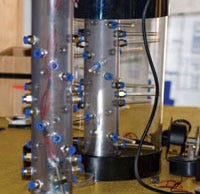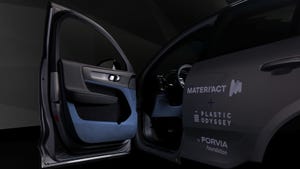Most oil reserves are actually prehistoric algae, and with more than a million species of algae and several different approaches at mass production, turning it into a feedstock for fuel and even plastics is a tricky task.While the fuel vs. food debate continues as to whether or not turning acres of corn or other food crops into ethanol or bioplastics is really a sustainable solution, other options exist for converting nonfood biomass into energy and plastics.
March 23, 2009
Most oil reserves are actually prehistoric algae, and with more than a million species of algae and several different approaches at mass production, turning it into a feedstock for fuel and even plastics is a tricky task.
While the fuel vs. food debate continues as to whether or not turning acres of corn or other food crops into ethanol or bioplastics is really a sustainable solution, other options exist for converting nonfood biomass into energy and plastics.
|
Algae cells can contain up to 60% oil, and for photosynthesis they use carbon dioxide, solar energy, and water—nicely sustainable. Exploring algae production for energy is not new, but finding a scalable, affordable way to produce enough for the potential demand has been difficult.
Luckily for the plastics industry, it takes plastic to make algae. A patent application for GreenFuel Technologies (Cambridge, MA) claims that the process would be able to produce 45,000 gal/acre/year of oil.
The ideal growing setting has been using polycarbonate (PC) tubes, as the material excels at transmitting the photosynthetically active radiation (PAR) used in photosynthesis, while it blocks out more unwanted UV than does acrylic or glass. But one expert estimates that, adding up the costs for the PC tubing and all the other operating expenses, crude oil would have to be more than $240/bbl to make the operation cost-competitive. And at that price, the PC’s cost would be much higher. At current prices, it would take 50 years to break even on the investment, and the PC tubes would need to be replaced every 10-15 years due to UV damage.
However, another idea to produce mass quantities of algae in minimal space and at minimal expense has been developed by Glen Kertz, president and CEO of Valcent Products Inc. (El Paso, TX). In October 2006, his company developed a system of vertically hanging flexible sheets with chambers connected on one end that create a closed-loop algae production environment, which Valcent calls a high-density vertical bioreactor. A 90-day continual production test in late 2007 showed that an algal species with a 50% lipid (oil) content could deliver approximately 33,000 gal/acre/year of algae oil. Tests on pH and CO2 levels, temperatures, and nutrients are helping Valcent optimize production yields.
OriginOil Inc. (Los Angeles, CA), another company working to optimize algae growth, developed a system to automate monitoring, solenoid operation, nutrient injection, and CO2 delivery at the micron level. Its Helix BioReactor utilizes low-energy lights arranged in a helix pattern and a rotating vertical shaft to allow algae culture to replicate exponentially within a small footprint. “From synthetic clothing to oxygen masks and toys, countless products are made from petroleum-based products,” said Riggs Eckelberry, OriginOil founder and CEO. “The successful automation of our Helix BioReactor is an enormous leap for us, as it brings us one step closer to ending this reliance on petroleum.”
Of course, one could argue that algae oil is a food, since it’s safe enough for cooking and is trans-fat free and healthy, similar to olive oil. With Kertz estimating large-scale production in the next three to five years, it might not be long until the fuel in your vehicle, the oil in your pan, and the plastic plates on which you serve meals are all derived from some pretty amazing pond scum. —[email protected]
WEB EXCLUSIVE
Click here for a 4-minute video on how Valcent makes its algae.
About the Author(s)
You May Also Like




